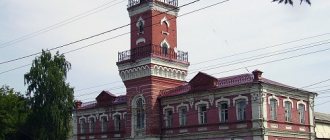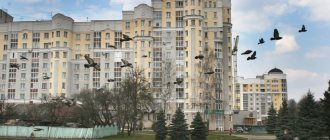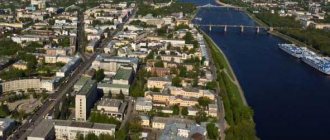This article is about territorial formation. About the city, see Bryansk.
| city of regional significance[1] / urban district[2] | |
| Bryansk city | |
| 53°15′ N. w. 34°25′ E. d.HGYAO | |
| A country | Russia |
| Included in | Bryansk region |
| Adm. center | Bryansk city |
| History and geography | |
| Date of formation | 2005 year |
| Square | 186.73[3] km² |
| Timezone | MSK (UTC+3) |
| Population | |
| Population | ↘417 096[4] people (2021) |
| Digital IDs | |
| auto numbers | 32 |
| OKATO | 15 401 000 000 |
Bryansk
, or
the city of Bryansk
, is an administrative-territorial unit (city of regional significance)[5][6] and municipal formation (urban district)[7][8][9] in the Bryansk region of Russia.
The urban district was formed as a result of municipal reform in 2005, within the boundaries of the territory of the pre-reform Bryansk City Council
.[10][11]
Where is Bryansk
Many people believe that Bryansk is located on the territory of Belarus. If you look at the map, you can see that it is located in the western part of the Central Russian Upland at an altitude of 250 meters above sea level. Having looked at where the city of Bryansk is located, you will see that it is located on the border of three Slavic states - Russia, Ukraine, and Belarus. The exact location is where two small rivers Snezheti and Bolva flow into the Desna.
Bryansk lies surrounded by numerous settlements: at a distance of 129 km from Orel, 232 km from Kaluga, 186 km from Zheleznogorsk, 173 km from Klintsy, 264 km from Kursk, 329 km from Vyazma, 384 km from Moscow.
Where to go in Bryansk on September 17, 2022
11.00 — Parade of troops and military equipment “We are the country’s army! We are the army of the people!”
Where: Lenin Square - Partizan Square
12.30 — Parade of Generations
Where: Lenin Avenue
13.00 – Rally “Bryansk Street leads us to victory!”
Where: Partizan Square
14.00 — Concert of the military exemplary orchestra “Let’s sing, friends together!” Demonstration performances of the honor guard company.
Where: Partizan Square
14.00 — Exhibition of military equipment
Where: Krasnoarmeyskaya street
15.00 — Festival of national creativity “Real Russia”. Performance by creative groups from Bryansk, Volgograd, Gomel, Mogilev
Where: Partizan Square
13.00 — Concert of the Bryansk City Pop Orchestra “To you, dear fellow countrymen!”
Where: Theater Square
13.30 — Festival of brass bands “On Bryanskaya Street with an orchestra”
Where: Slavyanskaya Square
17.00 — Historical reconstruction “For the Motherland! For my native city!
Where: old airport
14.30 — Concert from creative groups of the city “To you, beloved city!”
15.20 — Concert of the author of the “Afghan song” Valery Petryaev
16.00 — Concert of performers of the patriotic song “Katyusha”
17.30 — Concert of the song and dance ensemble of the Western Military District
18.30 — Concert of soloists of creative groups of the Bryansk region, accompanied by the governor’s symphony orchestra “Songs of Victory”
20.00 — Concert of singer Alexander Dobronravov
20.30- Concert of ethno-pop singer Varvara
Where: Main stage, park named after the 1000th anniversary of Bryansk
21.30 — Artillery salute and festive fireworks
Where: territory of the old airport, Mound of Immortality
Population of Bryansk
The population of Bryansk is 402,675 people. In terms of national composition, the main part are Russians and Ukrainians. In recent years, there has been a decrease in population growth, which can be seen from the table data.
| 2005 | 2006 | 2007 | 2008 | 2009 | 2010 |
| 424 100 | 420 000 | 416 200 | 413 900 | 411 798 | 415 721 |
| 2015 | 2016 | 2017 | 2018 | 2019 | 2020 |
| 407 256 | 405 921 | 406 553 | 405 723 | 404 793 | 402 675 |
Population[ | ]
| Population | ||||||
| 2002[12] | 2009[13] | 2010[14] | 2011[15] | 2012[16] | 2013[17] | 2014[18] |
| 450 289 | ↘430 172 | ↗435 245 | ↘434 560 | ↘432 033 | ↘429 940 | ↘427 357 |
| 2015[19] | 2016[20] | 2017[21] | 2018[22] | 2019[23] | 2020[24] | 2021[4] |
| ↘426 060 | ↘424 582 | ↗425 030 | ↘423 981 | ↘422 796 | ↘420 444 | ↘417 096 |
History of Bryansk
The history of its origin goes back to the last quarter of the 10th century. The city was founded as a fortress. Served as protection during the invasion of the Mongol-Tatar yoke. The dense forests here scared away enemies.
During the reign of Vladimir Monomakh, the “Straight Road” was built, which contributed to the strengthening of Rus'. During the attack of the Mongol-Tatars in XIII, the city was moved from Chashin Kurgan to Pokrovskaya Gora.
In 1356, the city, destroyed by the Tatars, was annexed to the Principality of Lithuania. Bryansk was returned to the Russian state by Ivan III in 1500. In 1607, the city was besieged twice by the troops of False Dmitry II.
Peter I built a shipyard in Bryansk. In 1783, factories for the production of field and siege artillery were introduced, and a joint-stock company was founded. At the end of the 19th century, Bryansk became a major railway center. In 1930 it received the status of a city of regional subordination.
From 1941 to 1943 the city was under the occupation regime of Nazi Germany. In 1944, Bryansk became the administrative center of the Bryansk region. In 1950, the village of Karachizh and the village of Uretsky joined. In 1956, Bezhitsa became a district of the city.
Settlements[ | ]
| № | Locality | Type of settlement | Subordination to the urban area | Population |
| 1 | White Shores | Urban-type settlement | Fokinsky district | ↘8354[4] |
| 2 | Bolshoye Polpino | Urban-type settlement | Volodarsky district | ↘5894[4] |
| 3 | Bryansk | city | ↘399 579[4] | |
| 4 | Raditsa-Krylovka | Urban-type settlement | Bezhitsky district | ↘3269[4] |
See also: Administrative division of Bryansk
Bryansk
A city in the Russian Federation, the administrative center of the Bryansk region, a city of regional significance, forms the municipal entity of the city of Bryansk with the status of an urban district.
It is located on the western edge of the Central Russian Upland, on both banks of the Desna River at the confluence of the Bolva and Snezheti.
The city is divided into 4 urban districts: Bezhitsky (includes the village of Raditsa-Krylovka), Volodarsky (includes the village of Bolshoye Polpino), Sovetsky, Fokinsky (includes the urban village of Belye Berega).
Bryansk is a large cultural, industrial center and logistics hub. The city is located in central Russia on the border with Ukraine and Belarus.
About a third of the region’s population lives in the city - about 420 thousand people (data for 2022). The total area of the city is 230 square kilometers.
History of the city of Bryansk
Bryansk, one of the oldest Russian cities, was founded in 985 as a Slavic fortified settlement on the high right bank of the Desna River. The original name of the city - "Debryansk" - is associated with the "wilds" surrounding the city - dense and impenetrable forests. Bryansk was first mentioned in the Ipatiev Chronicle in 1147: Prince Svyatoslav Olgovich of Novgorod took refuge in it. At this time, the city was part of the Chernigov principality.
Since 1252, the city acquired the status of the capital city of the appanage Bryansk principality, founded in 1246 by Prince Roman of Chernigov, who moved his capital here from Chernigov, devastated by Khan Batu. Under him, Bryansk became the political, economic and spiritual center of the region.
In 1356, the Principality of Bryansk was captured by the Grand Duchy of Lithuania, under whose rule Bryansk was for almost a century and a half. Only in 1500 did Russian troops capture the city. In 1503, after the end of the war between Ivan III and Lithuania, the northern part of the Bryansk Principality finally became part of the Moscow state.
Since that time, Bryansk has become an important fortress city on the southwestern borders of the state. At the same time, in the 16th century, on the site of the former Bryansk principality, the Bryansk district was formed, governed by governors.
During the Peter the Great era, a number of decrees were issued aimed at boosting industry and trade in the city. The annual fair held at the walls of the Svensky Monastery, one of the largest fairs in Russia, acquired a large role.
In 1708, Peter I visited Bryansk. By order of the tsar, a shipyard was founded in the city, where ships of the Bryansk flotilla were built.
In 1778, Bryansk became a county town in the Oryol province with its own coat of arms, noting its merits in the production of weapons and defense of the state.
In 1783, by decree of Catherine II, the construction of the Bryansk Arsenal began, and by the spring of 1785 the first cannons were cast here. Every fourth cannon that was in service with the Russian army in the Patriotic War of 1812 bore the mark of the Bryansk Arsenal. Rope spinning, tobacco, brick, sawmill and flour milling industries also developed in the city. Trade in timber, hemp, and hemp oil, sent to Moscow and the ports of Riga and St. Petersburg, was significant. By that time, the city had more than 13 thousand inhabitants.
With the construction of the Orel-Vitebsk railway in 1868, Bryansk was included in the transport network of Russia. In 1873, a rail rolling and iron-making mechanical plant was founded in the village of Bezhitsa, which soon became the largest enterprise for the production of steam locomotives and carriages.
After the Civil War, the city of Bryansk briefly became the center of a new territorial entity - the Bryansk province (1921-1929), after which it became part of the Western and then the Oryol region. During the Soviet period, the city grew into a major industrial center of the country. In 1931, the Bryansk State District Power Plant, built according to the GOELRO plan, came into operation.
The fighting during the Great Patriotic War and the occupation (October 1941 - September 1943) destroyed the city. The dedication of the residents who formed the people's militia, which bravely resisted the invaders, brought Bryansk the honorary title “City of Combat and Partisan Glory.” On September 17, 1943, Bryansk was liberated. Nowadays this day is celebrated as City Day.
In 1944, Bryansk became a regional center and in November 1945, by a special decree of the Soviet government, it was included in the list of fifteen oldest Russian cities subject to priority restoration. After the war, restoration began with the machine-building (locomotive) plant, which already produced the first steam locomotive in 1946.
In 1979, the city was awarded the Order of the October Revolution for success in economic and cultural construction, services in the revolutionary movement, courage and fortitude of workers during the Great Patriotic War, and active participation in the partisan movement. In 1985, for achievements in economic and cultural construction and in connection with the 1000th anniversary, Bryansk received the Order of the Red Banner of Labor.
On March 25, 2010, for the courage, resilience and mass heroism shown by the city’s defenders in the struggle for freedom and independence of the Fatherland, Bryansk was awarded the honorary title of the Russian Federation “City of Military Glory.”
Archeology
According to the Bryansk Museum of Local Lore, it currently contains more than 90 thousand items. This is one of the largest and most significant collections. It includes items discovered during archaeological research in the Bryansk region: tools, beads, bracelets, rings and other various finds.
Of particular value are the items discovered during the study of famous archaeological monuments of the Bryansk region: Khotylevo, Negotino, Eliseevichi, Timonovka, Yudinovo, Suponevo... The Bryansk region is rich in archaeological monuments, there are about 900 of them on its territory.
One of the oldest artifacts discovered in the Bryansk region is a flint spear tip. It is about 100 thousand years old. Despite such a considerable age, it is a real masterpiece in terms of care and beauty. The tip was found by an outstanding archaeologist and employee of our museum, Fyodor Mikhailovich Zavernyaev, at the Khotylevo-I site, 20 km from Bryansk.
At the neighboring parking lot Khotylevo-II F.M. Zavernyaev discovered two figurines of a woman made from mammoth ivory under a four-meter thick layer of earth. The age of these finds is about 18 thousand years. The figurines are one of the oldest works of art in the world. This is how the first “Paleolithic Venuses” appeared in the museum’s collection – this is the name these figurines received. These figurines are an archaeological rarity: about 100 of them have been found in the world.
Paleolithic collections from the funds of the Belarusian State Conservatory are comparable in volume, significance and value only to the collections of such major academic museums in Moscow and St. Petersburg as the State Historical Museum, the Museum of the Research Institute of Anthropology of Moscow State University, and the Kunstkamera.
Every year, domestic and foreign researchers work with the museum’s collections: archaeologists, philologists, museum employees, graduate students and undergraduates.
Coat of arms of the city of Bryansk
The Bryansk coat of arms is one of the oldest coats of arms of Russia; it was created in the first half of the 18th century. The opportunity to use an ancient coat of arms is a rare and high honor, which out of more than 20,000 municipalities currently existing in Russia can be enjoyed by less than 500.
For the first time, the coat of arms of Bryansk appeared on the banners of the Bryansk Landmilitary Regiment. Its first description appeared in 1730 in the collection of banners of the regiments of the Russian Empire - Znamenny Armorial. In 1781, Empress Catherine II, together with other coats of arms of the cities of the Oryol governorship, approved the coat of arms of the district city of Bryansk.
Description of the coat of arms
In the Russian State Archive of Ancient Acts in the “Coats of Arms of Cities and Counties of the Russian Empire” fund, the coats of arms of “regiments and battalions on banners and other regimental things”, submitted for approval by Catherine II on April 4, 1777, as city coats of arms, approved in 1775, have been preserved, including “Bryanskoy”, in color image. The upper field is red, on the lower field, which is a grass covering of green in different shades interspersed with brown, there is a golden mortar on a white carriage, on the sides of which there are pyramids of black cores with a white middle: on the right there are ten cores, on the left there are six cores of the same size.
The second description is contained in the Complete Collection of Laws of the Russian Empire in the “Book of Drawings and Drawings... of the Coats of Arms of Cities.” The chapter “Coats of Arms of the Oryol Viceroyalty” contains a lithograph of the coat of arms of the city of Bryansk with an image of a mortar standing on a carriage on a field and two pyramids of white cannonballs on its sides. The kernels on the left are larger, the kernels on the right are smaller. The image is black and white, there is a record of the approval of the coats of arms of the governorship on August 17, 1781. The symbol for the color of the top field is red. In the lower field, in addition to the image of the grass, several images of stones have been added.
The third brief description of the coat of arms of the city of Bryansk is contained in the “Description of the coats of arms of the cities of the Oryol governorship” with the appendix of the decree on the highest confirmation of coats of arms and sending copies to the governorship dated September 28, 1781. The following is reported about the coat of arms of Bryansk: “The city of Bryansk has an old coat of arms. In a red field there is a golden martyr with a pyramid of bombs placed on the sides.” This description of the coats of arms coincides with a similar description given in the Complete Collection of Laws in the text of the highest approved report of the Senate on the coats of arms of the cities of the Oryol governorship dated August 17, 1781.
Flag of the city of Bryansk
According to information sent by the Heraldic Council under the President of the Russian Federation, the flag of the city of Bryansk was drawn up with a deviation from the coat of arms principle adopted in our country: according to Russian traditions, city flags should be constructed by spreading the composition of the coat of arms over the entire panel. The flags of Moscow, St. Petersburg, and the vast majority of capital cities of the constituent entities of the Russian Federation are constructed in a similar way. In addition, flags built according to the German tradition (like the current flag of Bryansk - that is, with the coat of arms in a shield in the center of the panel), in addition to many other shortcomings, are non-functional and difficult to recognize from a distance. In this regard, the Chairman of the Heraldic Council, Georgy Vilinbakhov, pointed out the need to rework the flag of Bryansk and construct it according to the coat of arms principle.
Changes in the historical appearance of the coat of arms occurred in 2009, when city council deputies approved the official symbols of the regional center. According to their decision, the coat of arms of Bryansk began to be a French shield with a protruding point and lower rounded corners. The upper part of the shield is red, the lower part is green. The coat of arms contains golden mortars and cannonballs. Below them are depicted five elements, symbolizing young shoots of plants.
According to the Chairman of the Heraldic Council under the President of the Russian Federation, Georgy Vilinbakhov, on the coat of arms currently used, the golden shoots of plants in the lower part of the shield resemble arrows thrown on the battlefield, which, according to heraldic rules, indicates the weakness of the warriors and even their flight. It is also unacceptable to use the golden edging of the coat of arms, which symbolizes the deprivation of the merits of its owner. Also, to restore the original appearance, it is necessary to change the color of the cores from gold to black.
In addition, the Heraldic Council proposed supplementing the Bryansk coat of arms with elements reflecting the modern status of the city. In particular, the Heraldic Council developed a system of heraldic crowns for cities with different statuses. According to this, a five-tower crown can be added to the coat of arms of Bryansk, denoting the city district. A laurel wreath can be placed on the crown, indicating that Bryansk is the center of the subject of the Russian Federation. Also, due to the fact that in 2010 Bryansk became the City of Military Glory, crossed swords can be placed behind the crown as a symbol of this high rank.
Photo: Government of Bryansk region
Andrei Kartapolov and Vladimir Zhirinovsky will come to Bryansk for City Day
Deputy Minister of Defense of Russia, Head of the Main Military-Political Directorate of the Armed Forces, Colonel General Andrei Kartapolov will arrive in Bryansk to celebrate City Day. BryanskToday learned about this.
Andrey Kartapolov will take part in the celebrations marking the 75th anniversary of the liberation of the city from the Nazi invaders. This year, Bryansk will host festive events of unprecedented scale.
The decoration of City Day will be a parade of military equipment, in which T-72 tanks, BMP-2 tanks, artillery rocket launchers, and armored personnel carriers will take part. The column of equipment will be led by the legendary T-34 tank.
Let us remind you that this coming Monday, September 17, Bryansk will celebrate City Day, the 75th anniversary of liberation from the Nazis. Many high-ranking guests will come to the celebration.
Among them will be the leader of the LDPR, Vladimir Zhirinovsky. The Bryanskaya Street website reports this with reference to its sources. It is likely that he will take part in the parade.
Vladimir Zhirinovsky will also talk to the townspeople.









